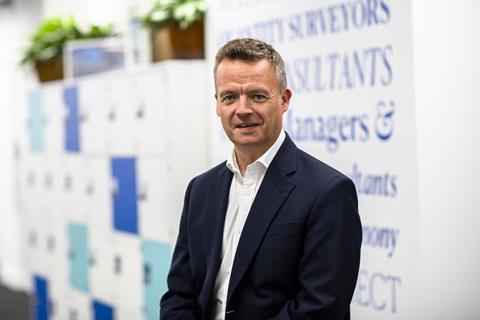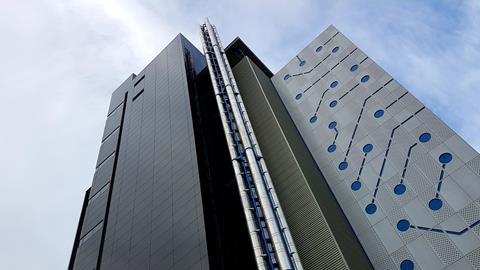Data centres are booming, so more firms are looking for a piece of the action. ��ɫ����TV asked industry veterans to share some advice for the newcomers

No matter how stubbornly it resists, it seems increasingly inevitable that the construction industry will follow the rest of the economy into what the Bank of England expects to be the longest recession on record.
In this somewhat gloomy future, many firms will no doubt be on the lookout for spots of continuing resilience across the industry and be considering diversification in order to reap the benefits.
One area which is bound to attract a lot of interest is the data centre market, with a Turner & Townsend survey last year showing 71% of data centre professionals viewed the sector’s construction market as less susceptible to recessionary pressures than other industries.
Sentiment among among investors remains similarly upbeat, with 95% of respondents to CBRE’s 2022 Global Data Center Investor Sentiment Survey (carried out last March) planning to increase their capital deployment in the sector.
CBRE predicted a “mammoth” fourth quarter for data centres in 2022 with 204MW of new supply expected to be delivered following an unusually quiet Q3 (12MW), and with Aecom predicting usage to increase tenfold between 2018 and 2050, demand seems set to go in one direction only. Just one megawatt is enough to power roughly 700 homes.
According to consultants Gartner, the global market for data centre construction was estimated to be worth £15bn in 2020 and is predicted to reach £24bn by 2027.
But while the bright lights of the data centre world may be alluring, the sector is not without its challenges and newcomers are by no means guaranteed success. ��ɫ����TV spoke to some sector veterans to find out what newcomers ought to know.
The FLAP
At their simplest, data centres are simply homes for huge numbers of clustered servers, which collect, store, process and distribute large amounts of data for companies. Many firms used to do this in-house, with the market for big data centres was mainly made up of banks and other financial services firms. As a result, the market has historically been focused around the continent’s financial centres, with the four cities that comprise the so-called FLAP (Frankfurt, London, Amsterdam, Paris) dominating activity.
The FLAP together has more than 2,500MW of supply, with London the biggest provider. Dublin is increasingly spoken of in the same breath as those four, while a series of secondary cities including Madrid, Warsaw and Milan are rapidly growing as the big boys experience constraints on supply and more and more companies decide to rent servers at co-location facilities (known as colos) or use cloud-based services operated by big tech companies.
According to Warren Pickance, managing director of contractor ISG, there are a handful of general contractors who have traditionally covered this trans-continental market, but breaking into this group is becoming more challenging as clients put increasing value on local supply chain capability, to the benefit of firms that have already put down roots.
“If you are not counting on one hand, it is not much more in terms of firms that have the track record and the capability to deliver schemes like this,” agrees Rennie Dalrymple, managing director at project managers Concert.

Firms like ISG, McLaren and John Sisk & Sons are among that handful, but according to Robert Thorogood, data centre lead at consultant HDR, the dominance of these contractors is “changing quite a bit because of the availability of staff and teams”, opening space for others – including traditionally M&E-focused contractors – to jump in.
What sets data centres apart from large multi-purpose structures such as warehouses or logistics centres is the complex mechanical and engineering challenge they face. Data centres must incorporate strategic cooling systems to lower the risk of damaging equipment, and systems to carefully monitor energy usage, while maximising the space available for the server cabinets.
The proportionally larger value of mechanical and engineering work on data centre projects – it can be as high at 70% of the job – has meant that M&E firms have often been able to find work as the main contractor or lead consultant, but Pickance cautions businesses not to overreach.
“When you enter a new location, and you’re building a potentially a large scheme, you need to make sure that all the all the early things regarding planning, supply chain, logistics and all those things are really considered, which may not be the strength of some of the engineering companies out there,” he says.
Moving to hyperscale
One of the major trends in recent years is the ramping up in scale, with the so-called “hyperscalers” becoming the dominant trend. While in the early years, much of the work done by data centres was based around banking hubs to help facilitate the financial system, today most developers lease to huge cloud operators such as Meta, Google, Microsoft and Amazon Web Services.
Sometimes these big tech companies will have their own data centres built and sometimes they will go to the market for provision, but for a huge portion of the market they are the end user.
The shift to hyperscale is “still an infrastructural change that is going on in the background”, says Thorogood, who adds that the new hyperscale clients have a relatively fixed way that they want their data centres built – a conservatism borne out of a fear of network downtime. “What these large tenants want, generally goes, because they have the power and influence to change a developer’s mindset rather than the other way around,” says Dalrymple.

The energy challenge
Perhaps the biggest threat to this – and to the growth of data centre construction in general – is the limitations on access to power. It is not grid capacity that is the problem, but rather the availability of powerful grid supply points, with distribution network operators in west London already expressing serious concerns.
This is hardly a surprise since, according to architect Nicholas Webb, one data centre his firm is working on in Hayes, west London, is set to use an amount of energy that will warrant a dedicated transformer in a National Grid substation. National Grid has a programme of upgrades, but clients in west London are currently trying to work around not having new power until 2027.

“That will ultimately put some people off trying to develop some sites,” says Thorogood. “Other people will find different ways around it, whether they’ll go for self-generation, or perhaps going for smaller power supplies and trying to generate on site, use storage […] there are there are ways and means to look at alternatives”.
While restrictions on power supply may have helped growth for the sector in secondary and tertiary cities, clients are cautious about increases in latency (delays in the transmission of data).
Webb says the government has recognised the crucial importance of this form of infrastructure and has begun instructing local authorities to treat them as special cases. “In locations [such as] brownfield sites, the government is asking the planning authority to be more lenient on what they would allow if it was a datacentre development than anything else on the B8 or sui generis use class,” he says.
The people problem
Alongside supply of energy, the dwindling supply of labour and record-breaking inflation in the price of materials, particularly metals, has been the other major challenge facing the sector. A report by Turner & Townsend published last autumn showed data centre clients were facing project costs 15% higher than last year on average and were experiencing delays of more than 12 weeks for some components.
More than nine in 10 survey respondents told T&T they were struggling to meet construction demand due to a shortfall of experienced site teams, as data centre projects compete with developers of other advanced manufacturing facilities across the world.
“If you’re serious about it […] you need to recruit the right people who’ve got that experience”
Robert Thorogood, HDR
The data centre market has “outgrown the numbers of staff available,” says Thorogood, with firms now being forced to pull staff from other parts of the industry, such as commercial fit-out, and re-purpose them. “That takes time, it’s not an overnight thing, it’s not the sort of thing you can do in a couple of weeks. It’s months, if not years, but you have to start somewhere,” he says.
>>See also: Cost model: Data centres
He says HDR has also looked to the process industry and chemicals industry, which have “similar traits” to data centres, for their staffing needs, while on the contractor side, ISG’s Pickance says his firm has brought staff in from the defence and healthcare building sectors. Thorogood says it is now not uncommon for a team of 10 to have two relative newbies onboard.
Thorogood warns newcomers that, while the “golden glow” of data centre construction might be appealing, it takes “a lot of time and effort” to break into the market. “If you’re serious about it, then I think you’d need to recruit the right people who’ve got that experience and be very diligent about how you do that,” he says.
“You’ve got to create a team that can then go and deliver, and then starts small-ish, and then gradually grow your projects […] It will probably take you three to five years to get a decent track record.”


























No comments yet